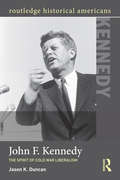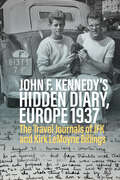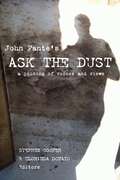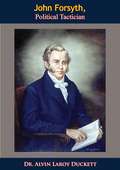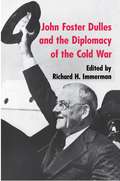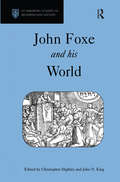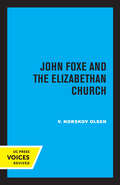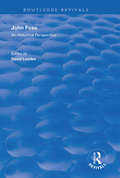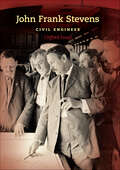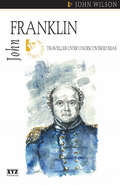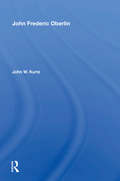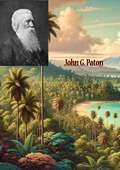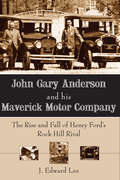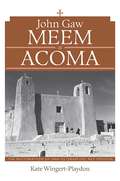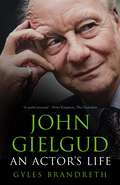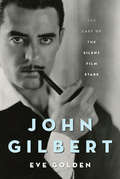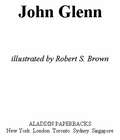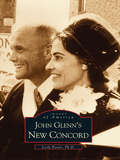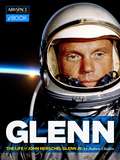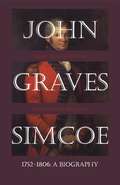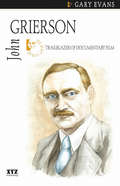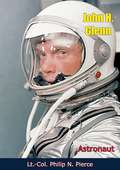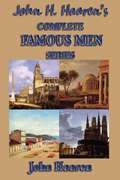- Table View
- List View
John F. Kennedy: The Spirit of Cold War Liberalism (Routledge Historical Americans)
by Jason K. DuncanHalf a century after his assassination, John F. Kennedy continues to evoke widespread fascination, looming large in America’s historical memory. Popular portrayals often show Kennedy as a mythic, heroic figure, but these depictions can obscure the details of the president’s actual achievements and challenges. Despite the short length of his time in office, during his presidency, Kennedy dealt with many of the issues that would come to define the 1960s, including the burgeoning Cold War and the growing Civil Rights movement. In John F. Kennedy: The Spirit of Cold War Liberalism, Jason K. Duncan explains Kennedy’s significance as a political figure of the 20th century in U.S. and world history. Duncan contextualizes Kennedy’s political career through his personal life and addresses the legacy the president left behind. In a concise narrative supplemented by primary documents, including presidential speeches and critical reviews from the left and right, Duncan builds a biography that elucidates the impact of this iconic president and the history of the 1960s.
John F. Kennedy’s Hidden Diary, Europe 1937: The Travel Journals of JFK and Kirk LeMoyne Billings
by Oliver LubrichPresenting the 1937 diaries of John F. Kennedy’s tour of Europe, this volume offers insights into his early experiences on a continent under the shadow of Nazism. In 1937, while still a student, John F. Kennedy undertook a grand tour of Europe with his close friend and traveling companion, Lem Billings. On this journey he began to keep a diary, which is reproduced here in full and provides an unadulterated account of his thoughts and feelings. Superficially, it presents a picture of two young men enjoying their summer, sightseeing, going to the movies, bars and night clubs; but behind this we find, in Kennedy’s political observations and encounters, the looming shadow of Nazism. In retrospect there are blind spots and misjudgments, but also insights of great topicality, for example on populism, and propaganda and its potent effects. On this trip and during his later travels in Germany, Kennedy engaged with the crucial questions of his later presidency: How does a dictatorship work? How is an alternative concept of society to be countered? And how can an impending war be averted? Kennedy’s European and Russian policies and also his famous Berlin speech of 1963 (“Ich bin ein Berliner”) are to be understood against this background. In addition to numerous archive photographs, this volume contains Kennedy’s complete diary of his 1937 trip to Europe and, as a counterpart, the “Scrapbook” of Lem Billings who documented it from his perspective.
John Fante's Ask the Dust: A Joining of Voices and Views (Critical Studies in Italian America)
by Stephen Cooper and Clorinda DonatoThis volume assembles for the first time a staggering multiplicity of reflections and readings of John Fante’s 1939 classic, Ask the Dust, a true testament to the work’s present and future impact.The contributors to this work—writers, critics, fans, scholars, screenwriters, directors, and others—analyze the provocative set of diaspora tensions informing Fante’s masterpiece that distinguish it from those accounts of earlier East Coast migrations and minglings. A must-read for aficionados of L.A. fiction and new migration literature, John Fante’s “Ask the Dust”: A Joining of Voices and Views is destined for landmark status as the first volume of Fante studies to reveal the novel’s evolving intertextualities and intersectionalities.Contributors: Miriam Amico, Charles Bukowski, Stephen Cooper, Giovanna DiLello, John Fante, Valerio Ferme, Teresa Fiore, Daniel Gardner, Philippe Garnier, Robert Guffey, Ryan Holiday, Jan Louter, Chiara Mazzucchelli, Meagan Meylor, J’aime Morrison, Nathan Rabin, Alan Rifkin, Suzanne Manizza Roszak, Danny Shain, Robert Towne, Joel Williams
John Fawcett's Ginger Snaps
by Ernest MathijsFew studies of Canadian cinema to date have engaged deeply with genre cinema and its connection to Canadian culture. Ernest Mathijs does just that in this volume, which traces the inception, production, and reception of Canada's internationally renowned horror film, Ginger Snaps (2000). This tongue-in-cheek Gothic film, which centres on two death-obsessed teenage sisters, draws a provocative connection between werewolf monstrosity and female adolescence and boasts a dedicated world-wide fan base.The first book-length study of this popular film, John Fawcett's Ginger Snaps is based on the author's privileged access to most of its cast and crew and to its enthusiasts around the world. Examining themes of genre, feminism, identity, and adolescent belonging, Mathijs concludes that Ginger Snaps deserves to be recognized as part of the Canadian canon, and that it is a model example of the kind of crossover cult film that remains unjustly undervalued by film scholars.
John Florio
by Hermann W. HallerA Worlde of Wordes, the first-ever comprehensive Italian-English dictionary, was published in 1598 by John Florio. One of the most prominent linguists and educators in Elizabethan England, Florio was greatly responsible for the spreading of Italian letters and culture throughout educated English society. Especially important was Florio's dictionary, which - thanks to its exuberant wealth of English definitions - made it initially possible for English readers to access Italy's rich Renaissance literary and scientific culture. Award-winning author Hermann W. Haller has prepared the first critical edition of A Worlde of Wordes, which features 46,000 Italian entries - among them dialect forms, erotic terminology, colloquial phrases, and proverbs of the Italian language. Haller reveals Florio as a brilliant English translator and creative writer, as well as a grammarian and language teacher. His helpful critical commentary highlights Florio's love of words and his life-long dedication to promoting Italian language and culture abroad.
John Forsyth: Political Tactician
by Dr Alvin Laroy DuckettFirst published in 1962, this is a biography of John Forsyth (1780-1841), who was Governor of Georgia and Secretary of State under both Andrew Jackson and Martin Van Buren. Alvin Laroy Duckett chronicles Forsyth’s achievements portraying him as one of Georgia’s most versatile and accomplished politicians.Forsyth was elected Attorney General of Georgia at the age of 28, the first public office he held. He went on to serve as U.S. Representative, Senator, and as a Minister to Spain. He was a leader among a group of southern republicans that helped to win the presidency for Andrew Jackson. Forsyth fought nullification, oversaw the government’s response to the Amistad case, and led the pro-removal reply to the Indian Removal Act of 1830. Though he worked primarily at the federal level, Forsyth also contributed greatly to the development of Georgia during his career.
John Foster Dulles and the Diplomacy of the Cold War
by Richard H. ImmermanAs Dwight D. Eisenhower's Secretary of State, John Foster Dulles came to personify the shortcomings of American foreign policy. This collection of essays, representing the first archivally based reassessment of Dulles's diplomacy, examines his role during one of the most critical periods of modern history. Rejecting familiar Cold War stereotypes, this volume reveals the hidden complexities in Dulles's conduct of foreign policy and in his own personality.
John Foxe and his World (St Andrews Studies in Reformation History)
by John N. King Christopher HighleyInterest in John Foxe and his hugely influential text Acts and Monuments is particularly vibrant at present. This volume, the third to arise from a series of international colloquia on Foxe, collects essays by established and up-and-coming scholars. It broadly embraces five major areas of early modern studies: Roman Catholicism, women and gender, visual culture, the history of the book and historiography. Patrick Collinson provides an entire overview of the field of Foxe studies and further essays place Foxe and his work within the context of their times.
John Foxe and the Elizabethan Church
by V. Norskov OlsenThis title is part of UC Press's Voices Revived program, which commemorates University of California Press’s mission to seek out and cultivate the brightest minds and give them voice, reach, and impact. Drawing on a backlist dating to 1893, Voices Revived makes high-quality, peer-reviewed scholarship accessible once again using print-on-demand technology. This title was originally published in 1973.
John Foxe: An Historical Perspective (Routledge Revivals)
by David LoadesFirst published in 1999, This book is a wide-ranging and authoritative review of the reception in England and other countries of Foxe’s Acts and Monuments of the English Martyrs from the time of its original publication between 1563 and 1583, up to the nineteenth century. Essays by leading scholars deal with the development of the text, the illustrations and the uses to which the work was put by protagonists in subsequent religious controversies. This volume is derived from the second John Foxe Colloquium held at Jesus College, Oxford in 1997. It is one of a number of research publications designed to support the British Academy Project for the publication of a new edition of Foxe’s hugely influential text.
John Frank Stevens: Civil Engineer (Railroads Past and Present)
by Clifford FoustOne of America's foremost civil engineers of the past 150 years, John Frank Stevens was a railway reconnaissance and location engineer whose reputation was made on the Canadian Pacific and Great Northern lines. Self-taught and driven by a bulldog tenacity of purpose, he was hired by Theodore Roosevelt as chief engineer of the Panama Canal, creating a technical achievement far ahead of its time. Stevens also served for more than five years as the head of the US Advisory Commission of Railway Experts to Russia and as a consultant who contributed to many engineering feats, including the control of the Mississippi River after the disastrous floods of 1927 and construction of the Boulder (Hoover) Dam. Drawing on Stevens's surviving personal papers and materials from projects with which he was associated, Clifford Foust offers an illuminating look into the life of an accomplished civil engineer.
John Franklin
by John WilsonJohn Franklin explored and charted Canada’s arctic seacoast in 1819-1822, 1825-27, and 1845. On the first expedition he nearly starved and on the third he died. None of his men survived the third expedition, but the search for clues to their fate helped open up the North and his celebrated Canadian song and stories.
John Frederick Oberlin/h
by John W. KurtzThis book covers the life of John Frederic Oberlin from his adolescence to his death. It provides adequate details of the relationships between Oberlin's life and work and the social and intellectual currents of his time, with impartiality and rational perspective.
John G. Paton
by John G. PatonThe Autobiography of John G. Paton recounts the extraordinary life and missionary work of John G. Paton, a 19th-century Scottish missionary who devoted much of his life to spreading Christianity among the indigenous peoples of the New Hebrides (modern-day Vanuatu). This deeply personal and inspiring memoir captures the challenges, triumphs, and unwavering faith that defined Paton’s work in one of the most remote and dangerous mission fields of his time.The narrative begins with Paton’s early life in Scotland, where he grew up in a devout Christian household that shaped his lifelong calling to serve others. He shares his struggles and successes in becoming a missionary and the profound sense of purpose that drove him to leave behind the familiar comforts of home for the harsh realities of missionary life among island communities known for their resistance to foreign influence.Paton’s experiences in the New Hebrides are both harrowing and inspiring. He recounts narrow escapes from danger, confrontations with local tribal customs, and the heartbreak of personal losses, including the deaths of his wife and child. Despite the hardships, his story is also one of hope, as he witnesses profound changes in the lives of the people he serves, including their gradual acceptance of Christianity.This autobiography is more than a missionary journal—it reflects on themes of perseverance, cultural exchange, and the power of faith in the face of adversity. Paton’s accounts offer valuable insight into the complexities of 19th-century missionary work, balancing his religious zeal with respect for the people he sought to convert.The Autobiography of John G. Paton remains a timeless testament to the courage, conviction, and compassion of one man’s mission. It continues to resonate with readers interested in missionary history, Christian faith, and stories of cross-cultural engagement and endurance.
John Gary Anderson and his Maverick Motor Company: The Rise and Fall of Henry Ford's Rock Hill Rival
by J. Edward LeeTo John Gary Anderson, a well-designed, well-made, well-marketed car would speed to the head of the pack, leaving the bewildered competition in its dust. John Gary Anderson?the hungry visionary who founded the Anderson Car Company and attempted to revitalize Rock Hill, South Carolina, as the automobile capital of the country - never forgot where he came from and never lost sight of where he wanted to go. Born into poverty during the Civil War, Anderson's industrial ingenuity and drive would come to symbolize the New South, and his devotion to the economic livelihood of his home would not be forgotten. At the beginning of the twentieth century, Anderson was poised for unstoppable success in the new automobile industry - until it all came crashing down.
John Gaw Meem at Acoma: The Restoration of San Esteban del Rey Mission
by Kate Wingert-PlaydonBuilt by Spanish Franciscan missionaries in the seventeenth century, the magnificent mission church at Acoma Pueblo in west-central New Mexico is the oldest and largest intact adobe structure in North America. But in the 1920s, in danger of becoming a ruin, the building was restored in a cooperative effort among Acoma Pueblo, which owned the structure, and other interested parties. Kate Wingert-Playdon&’s narrative of the restoration and the process behind it is the only detailed account of this milestone example of historic preservation, in which New Mexico&’s most famous architect, John Gaw Meem, played a major role.
John Gielgud: An Actor's Life
by Gyles Brandreth‘A sense of delight permeates Gyles Brandreth’s John Gielgud: An Actor’s Life … Brandreth combines neat reportage, deft evocation and lovely tales about a man he knew and relished.’ – The Times‘A delightful memoir which tells you all you need to know and collects all the anecdotes.’ – Daily MailJohn Gielgud was born in April 1904. When he died in May 2000, he was honoured as ‘the giant of twentieth-century theatre’. In this updated, acclaimed biography, Gyles Brandreth draws from over thirty years of conversations with Gielgud to tell the extraordinary story of a unique actor, film star, director and raconteur.In 1921 Gielgud made his first appearance at the Old Vic in London and through the next eight decades he dominated his profession – initially as a classical actor, later in plays by Harold Pinter and Alan Bennett. In his twenties he had appeared in silent movies; more than half a century later, he emerged as a Hollywood star, winning his first Oscar at the age of seventy-eight.With wonderful anecdotes, and contributions from Kenneth Branagh, Alec Guinness, Paul Scofield, Donald Sinden, Judi Dench and Peter Hall, John Gielgud: An Actor’s Life is a compelling, humorous and moving account of a remarkable man.
John Gilbert: The Last of the Silent Film Stars (Screen Classics)
by Eve GoldenThis revealing biography of the legendary silent film star chronicles his meteoric rise, famous romances, and tragic descent into obscurity. Known as &“The Great Lover,&” John Gilbert was among the world's most recognizable actors during the silent era. A swashbuckling figure on screen and off, he is best known today for his high-profile romances with Greta Garbo and Marlene Dietrich, his legendary conflicts with Louis B. Mayer, his four tumultuous marriages, and his swift decline after the introduction of talkies. Many myths have developed around the larger-than-life star in the eighty years since his untimely death, but this definitive biography sets the record straight. Eve Golden separates fact from fiction in John Gilbert, tracing the actor's life from his youth spent traveling with his mother in acting troupes to the peak of fame at MGM, where he starred opposite Mae Murray, Norma Shearer, Joan Crawford, Greta Garbo, and others in popular films such as The Merry Widow, The Big Parade, Flesh and the Devil, and Love. Golden debunks some of the most pernicious rumors about Gilbert, including the oft-repeated myth that he had a high-pitched, squeaky voice that ruined his career. Meticulous, comprehensive, and generously illustrated, this book provides a behind-the-scenes look at one of the silent era's greatest stars and the glamorous yet brutal world in which he lived.
John Glenn
by Robert Brown Michael BurganDear Reader: The Childhood of Famous Americans series, sixty-five years old in 1997, chronicles the early years of famous American men and women in an accessible manner. Each book is faithful in spirit to the values and experiences that influenced the person's development. History is fleshed out with fictionalized details, and conversations have been added to make the stories come alive to today's reader, but every reasonable effort has been made to make the stories consistent with the events, ethics, and character of their subjects. These books reaffirm the importance of our American heritage. We hope you learn to love the heroes and heroines who helped shape this great country. And by doing so, we hope you also develop a lasting love for the nation that gave them the opportunity to make their dreams come true. It will do the same for you. Happy Reading! The Editors
John Glenn's New Concord (Images of America)
by Lorle PorterI've always believed that New Concord and Muskingum College are the center of the universe, because if you get your start here, you can go anywhere. This quote from John Herschel Glenn Jr. is the perfect summation of a wonderfully Midwestern town that produced one of the great American citizens of all time. The Village of New Concord, founded in 1828, had humble enough beginnings. Over the course of the next century and a half, however, the growth of the entire country was played out on New Concord's stage as residents faced a series of revolutionary frontiers: Zane's Trace, the National Road, U.S. Route 40, Interstate 70, and finally, space. New Concord, like the rest of the country, struggled through two world wars, the Great Depression, and social turmoil. Unlike the rest of the country, it also produced a hero.
John Glenn: America's Astronaut
by Andrew ChaikinIn February 1962, he became the first American to orbit the Earth. Since then John Herschel Glenn Jr. has stood in the popular imagination as a quintessentially American hero. In John Glenn: America's Astronaut, a special edition e-book featuring 45 stunning photographs as well as a video, Chaikin explores Glenn's path to greatness. John Glenn features new details on Glenn's selection as an astronaut in 1959, newly synchronized onboard film and audio of Glenn's harrowing reentry from orbit on his 1962 Mercury mission, rarely seen images of Glenn in orbit and from the John Glenn archives at Ohio State University, as well as new, touching reminiscenes of Glenn's 1998 return to space from his Space Shuttle crewmates. Glenn is the embodiment of the history of human spaceflight and the indefatigable American spirit, and John Glenn: America's Astronaut is his amazing story.
John Graves Simcoe 1752-1806: A Biography
by Mary Beacock Fryer Christopher DracottOne of the legendary figures of Ontario history, John Graves Simcoe was the commander of the Queen’s Rangers during the American Revolution. In 1791 he was appointed the first lieutenant-governor of Upper Canada, and upon his arrival in 1792 he founded the town of York (present-day Toronto). John Graves Simcoe completes a trilogy of Simcoe books published by Dundurn Press. Mary Beacock Fryer’s Elizabeth Posthuma Simcoe was first published in 1989, while Our Young Soldier: Lieutenant Francis Simcoe, 6 June 1791-6 April 1812 was released in 1996. For this third volume, Fryer has teamed with Christopher Dracott, whose vantage point from Devonshire, England helps to provide this book with a complete view of Simcoe’s life.
John Grierson
by Gary EvansJohn Grierson, founder of both the British documentary film movement and the National Film Board of Canada, was one of the twentieth centurys most influential personalities in film culture. He gave the word "documentary" to the English language.
John H. Glenn, Astronaut
by Lt.-Col. Philip N. PierceAT 9:47 on the morning of February 20, 1962, American life came to a breathless halt as millions paused to listen and watch while a mighty rocket hurled a man-carrying capsule into orbit around the earth.The successful flight and safe return of Marine Astronaut Lt.-Col. John Herschel Glenn, Jr., have given his name a luster that few other American names have ever achieved.But John Glenn is more than a name. He is a dedicated maker of history who modestly believes that his God-given talents, and his ability and opportunity to use them, are his destiny—indeed his duty to his country and the world.Here, written by men who know him, is the biography of that remarkable man and his historic flight.
John H. Haaren's Complete Famous Men Series
by John HaarenCollected here in one omnibus edition are all four of John H. Haaren's Famous Men Series. Included are Famous Men of Greece, Famous Men of Rome, Famous Men of the Middle Ages, and Famous Men of Modern Times. These four books will entertain and enlighten your children. They will inform about Aristotle, Ptolemy, Ulysses, Pericles, Alexander the Great, Horatius, Camillus, Caesar, Cicero, Marcus Aurelius, Attila the Hun, Charlemagne, William the Conqueror, Edward the Black Prince, Joan of Arc, Lorenzo de Medici, Christopher Columbus, Galileo, Newton, Napoleon, Gladstone, George Washington, and many, many others.
